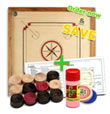|
Secure shopping Checkout our new range of board games, classic and table games. Snooker, Pool, Monopoly, Scrabble, Chess, Draughts (Checkers), Cranium, Air Hockey, backgammon. Balance boards for sale. We now offer Classic, table and board games including Risk, Air Hockey, Monopoly, Foosball, chess, backgammon, cranium and more for sale - Low delivery charges to the US. "All carroms board sets come with everything needed to play instantly, including rules, carrom men, spares, striker and powder). Play now for free ! |
Backgammon RulesThe rules of backgammon. These rules are provided by Masters Traditional Games, an Internet shop selling quality traditional games, pub games and unusual games. We publish free game rules in order to promote game playing around the world. To find out more, visit the website www.mastersgames.com or email custserv@mastersgames.com. You are welcome to print, copy or pass these rules on but only in their original form including the copyright and the information about Masters Traditional Games. The disclaimer on the Masters Traditional Games website applies. These rules are comprehensive instructions for friendly play. They are not a complete set of standard regulations encompassing all situations that might be encountered. If in doubt, players should always abide by locally-played or house rules. Two variations of Backgammon are included after the main rules - Dutch Backgammon and Acey Deucey, a game popular within the American armed forces. BackgammonEquipment The game of Backgammon is played on a specially designed board consisting of four tables of six thin triangles or points on each table. The points start from the edges of the board nearest the players and are directed inwards so that they form two rows of 12 points opposite each other. A bar bisects the board and the two tables on one side are designated the "inner tables" or "home tables", the others being referred to as the "outer tables". Traditionally, the inner tables should be positioned facing the greatest light source. There are fifteen white disks, fifteen black disks, two dice, two dice shakers and a doubling cube. The doubling cube is a die having the numbers 2, 4, 8, 16, 32 and 64 inscribed upon its 6 faces. Preparation and Objective Each player attempts to move all his pieces into the inner table nearest to him (his home table) and once that is achieved, to move or "bear" the pieces off the board. The first player to do this wins. However, that is only half the story because backgammon is not being played properly unless it is being played for stakes. So the ultimate objective of a Backgammon match is to win more stakes than the opponent. Starting Pieces can only move in one direction - from the opponent's inner table through the opponent's outer table, back through the player's outer table and finishing in the player's inner table. White pieces move in a clockwise direction, Black moves in an anti-clockwise direction. Since the inner tables point towards the light, it should therefore be clear who sits where. For the purposes of describing the starting position, the points will be numbered1 to 12 on either side of the board starting with the first square of the inner table and finishing with the last square of the outer table. On Black's side, position 2 white pieces on point 1, 5 black pieces on square 6, 3 black pieces on square 8 and five white pieces on square 12. White's side should mirror this arrangement exactly. Although Backgammon is played for stakes, this does not necessarily mean money - one can use counters, beans or one can just keep a score with pen and paper. However, the gambling element can be eliminated completely by following the normal rules and merely ignoring the doubling cube and the stakes. Normally, however, a stake is decided up front be it monetary or otherwise. To begin, each player rolls one die each at the same time. If a double is rolled, then the stake is doubled and both players roll again. This is repeated until one player rolls a higher number than the other. The player with the highest throw then uses the dice throw from both players to take the first turn and also chooses to play white or black (and thus which side to sit). Doubling and stakes At any time after the first turn, either player can offer to double the stakes prior to casting the dice. Upon being presented with such an ultimatum, the other player must choose either to forfeit the game and the current stake or accept the offer. Once the stake has been doubled once in this way, only the player who accepted the most recent offer to double the stake can offer to re-double it. Whenever this happens, the other player either forfeits the game or accepts the double and the opportunity to offer the next double. The doubling cube is used to record the current amount of the stake. Basic Play Each turn consists of the opportunity to move counters towards the player's inner table according to the roll of the two dice. Unless a double is thrown, two moves are allowed, one for each number on the dice. When a double is thrown, four moves are allowed of the number on the dice. Player's are not allowed to pass on their moves - as many moves as possible must be made each turn. A point hosting two or more of the opponent's pieces is said to be "blocked". If six points in a row are blocked, the opponent is said to have formed a "prime". This is a highly advantageous achievement because a prime cannot be traversed by an opponent but is completely free to be traversed by the player who created it. Bearing Off Once all pieces are present in a player's inner table, that player can start "bearing off". A throw of 1 allows a player to bear off a piece from point 1 of his inner table, a throw of 2 allows a player to bear off a piece from point 2 of his inner table and so on. Pieces borne off are simply removed from the board. Player's do not have to bear off - if available, they can choose to move a piece within their inner table instead. This is often done to pair up singlets in order to prevent them from capture. When a player rolls a number that is higher than the highest point of the inner table upon which that player has pieces, the player is allowed to bear off the next highest piece. For example, with a roll of double 5, if the player has a piece on point 5, two pieces on point 3, one piece on point 2 and one piece on point 1, the player would bear off the four highest placed pieces and be left with just one piece on point 1. If after starting to bear off, a player's piece is captured, that piece must re-enter at the other side of the board and bearing off cannot re-start until all pieces are once again residing in the inner table. Finishing The first player to bear off all pieces wins the game.
Dutch Backgammon This is played in the same way as Backgammon with only 2 differences: • All the pieces start off the board "in hand" and all 15 must be entered on the opponent's inner table before any can proceed further
Acey Deucey This gambling game is popular with the US military forces and is similar to Dutch Backgammon - the keynote feature is that a throw of a 1 and a 2 is a special throw called "acey deucey". It is played in the same way as backgammon with the following rule differences: • At the beginning, the player who starts also chooses which table to enter and the opposing player must enter on the opposite table and travel in the opposite direction. This, of course, is a purely cosmetic modification to the rules and does not affect the outcome of the game at all.
Copyright © 1999 Masters Games. All rights reserved
If you are looking to buy backgammon, then please checkout our backgammon games |
Don't want to Buy? A range of games either to play online or download. PC, Java & Flash versions currently available. Try our Free games If you need to repair your game just contact us. Our London based company is also the carrom board supplier for UK competitions. Our competition size board is used as the Carrom Association pro standard. |
About us | Resources | Wholesale | Blog | Games Forums © Copyright 2000 - 2005 Carrom board game shop


